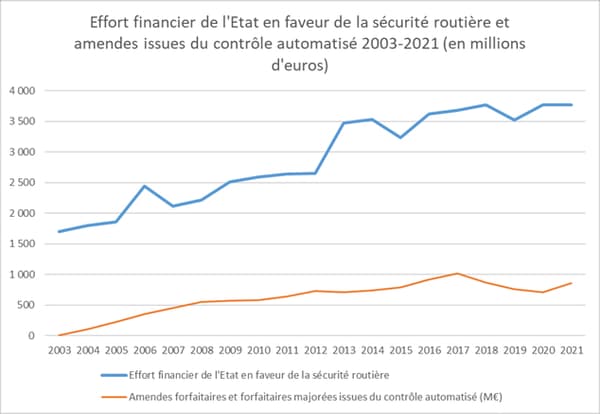It was exactly 20 years ago. On October 27, 2003, a certain Nicolas Sarkozy, then Minister of the Interior, inaugurated France’s first automatic radar. A presentation along the RN20 near Ville-du-Bois (Essonne), a few days before the activation of the first cabins.
For the record, the man who would become President of the Republic in 2007, as well as the then Minister of Transport, Gilles de Robien, were caught speeding on the route to this event. Not by gendarmes, but by journalists from the magazine. Auto Plus equipped with a binocular radar, as reported in this article from the France 3 television news. A bad example… which suggests a great “success” for automatic radars.
The fantasy of a jackpot
“These new radars are the first parts of the ‘automatic sanction control’, which allow offending motorists to be flashed, edited and automatically sent a fine to the vehicle owner,” AFP summarizes.
On October 31, the topic appeared on the front page of France 2’s 1:00 p.m. news: “For an hour now, throughout France, the first ten automatic radars of a series of 100 have been able to operate and photograph at any time of the day.” day. … speeding day and night,” explains presenter Daniel Bilalian.
The installation of the first radars already opens a debate that has since become recurrent: does this device represent above all an advance in road safety or rather a way for the State to generate significant income?
On the “money pump” part, confirmation will happen fairly quickly. In the France 2 news of November 24, 2003, there was talk of “a real jackpot for public finances.”
The report takes the example of an automatic radar near the Pont de Neuilly, in the Paris region. In just one week, “it has already paid for itself,” with 1,000 vehicles sanctioned at 90 euros per fine, or an income of 90,000 euros.
“A bigger prize that will make it possible to finance the 500 new radars planned for 2004”, underlines the theme of France 2.
The income estimates are dizzying: with 500 radars, 200 fines per day and fines of 90 euros, they could generate more than 3 billion euros per year. A sum that is then compared with the income from the Wealth Solidarity Tax (ISF), which generates around 2.5 billion euros each year.
In reality, fines generated by speed cameras will never reach this crazy estimate.
In the following graph available on the page “What is speed camera money used for?” From the official road safety website it appears that these revenues have never exceeded 1,010 million euros in 2017. An important contribution, but lower than the financial effort of the State in favor of road transport safety, which represents more than 3,500 million of euros since 2015.

Undeniable consequences in reducing mortality
Beyond filling the state coffers, radars are often presented as the cause of the sharp decline in the number of deaths on the roads.
True or false? Vast debate. In fact, the decline in the number of deaths on France’s roads has accelerated since the early 2000s: from 7,655 deaths in 2002, the country fell below the 4,000 deaths in 2011 (3,541 people died in 2022).
An undeniable role of radars in raising collective awareness about the need to moderate speed and, therefore, respect the current limits. But to which we can still add the rest of the measures adopted to improve security.
One example among others: the ban on using the phone while driving in France also dates back to 2003, the year of the first automatic radars. Conduct now punishable with the withdrawal of 3 points from the driving license and a fixed fine of 135 euros. Since 2020, The withdrawal of the license is also provided for in case of accumulation with another crime..
Another element that will probably weigh in this annual road mortality report: the greater safety of recent vehicles in their design and the protection of occupants in the event of an accident.
A symbol of the protests.
In short, this is another measure aimed at improving road safety that will set radars on fire: given the implementation of the speed of 80 km/h in 2018, within the framework of the yellow vest movement, many protesters will attack this fort symbol. The result: 60% of the radar park was degraded at different levels, from deteriorated to destroyed, noted the Minister of the Interior, Christophe Castaner, at the beginning of 2019. A rate that will increase to 75% a few months later.
The radars already pointed to the “red hats” against the ecotax in 2013, to the tobacconists against the increase in the price of a pack of cigarettes in 2020, or more recently as part of the movement against pension reform, he recalls. The office. An article that even dates the first demotion… to our original radar from October 27, 2003, attacked with a “stone, hammer or sledgehammer” two days after its inauguration.
Now re-established and well established on the French road landscape, the flashing booth network continues to diversify.
In 2022, there were a total of 4,447 radars of all types: 1,425 “fixed speed radars”, 1,098 “turret radars (speed and crossing)” and 340 “autonomous radars” (those fixed and mobile radars), details a report from the Senate. We can add radars focused on violations other than speed: 540 red light radars and 75 level crossing radars. Finally, let’s not forget the 973 radars installed on vehicles of private companies, which carried out nearly 18,000 daily checks in 2021.
Finally, the arrival of multifunction radars has long been announced, capable of detecting non-compliance with the use of seat belts, respect for safety distances or even the use of the telephone while driving. Testing continues pending its commissioning, suspended last March.
Source: BFM TV

